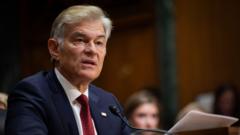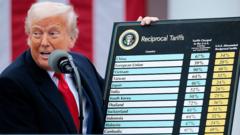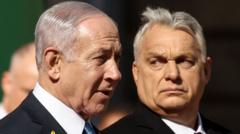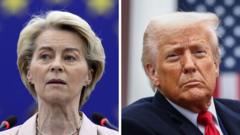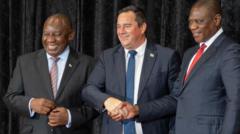President Donald Trump's tariffs, calculated primarily through a formula based on trade deficits, have raised significant discussion on their effectiveness and economic rationale. Critics argue these tariffs may not achieve their intended goals, potentially harming the global economy.
Understanding the Calculations Behind Trump's Tariff Strategy
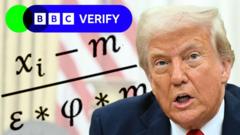
Understanding the Calculations Behind Trump's Tariff Strategy
An analysis of how President Trump's tariffs were determined, exploring their implications on trade and the broader economy.
US President Donald Trump's administration has enacted a series of tariffs, with a standard 10% rate on most imports, escalating charges for countries deemed "worst offenders." The methodology behind these tariffs has come under scrutiny, prompting analyses to reveal their underlying calculations. Initially presented in a dramatic fashion at the White House, expectations were that the tariff charges would stem from a mixture of pre-existing tariffs and various trade impediments. However, further examination showed a more straightforward mathematical approach guiding the tariff rates.
The White House released a formula: calculating the trade deficit with a particular country, dividing it by total imports from that country, and then halving the result. A trade deficit indicates a scenario where imports outstrip exports; for example, with China, the U.S. has a deficit of $295 billion against $440 billion in goods bought. The division yields approximately 67%, which, when halved and rounded, translates into a tariff of 34%.
However, the tariffs have drawn criticism for not being reciprocal. Reciprocal tariffs would align with the tariffs imposed by other countries on U.S. goods, but the White House's methods diverge from this principle. Instead, tariffs were structured to address the goals of reducing trade deficits, not correlating them with the existing tariffs of other nations.
Notably, Trump's administration has applied tariffs on countries with which the U.S. has a trade surplus, such as the UK, which has received a 10% tariff despite a favorable trade balance for the U.S. In total, tariffs have been imposed on over 100 nations as part of this new strategy.
The rationale behind Trump's tariffs is to address what he perceives as an unfair global trading environment, protecting U.S. jobs and manufacturing by countering the influx of cheaper foreign goods while targeting nations that he accuses of erecting barriers against American products. However, economists express skepticism about the efficacy of these tariffs. Many believe they may lead to a reduction in trade deficits between the U.S. and individual nations but are unlikely to affect the overall trade balance, which is shaped by broader economic dynamics, such as consumer spending patterns and investment behavior.
Professor Jonathan Portes from King's College argues that the tariffs will bring about numerous unmeasured consequences, while economist Thomas Sampson suggests that the formula lacks sound economic justification and may yield detrimental effects on the global economy. The debate over the effectiveness of Trump's tariffs continues, highlighting complex interactions in international trade and their impact on domestic policy.

